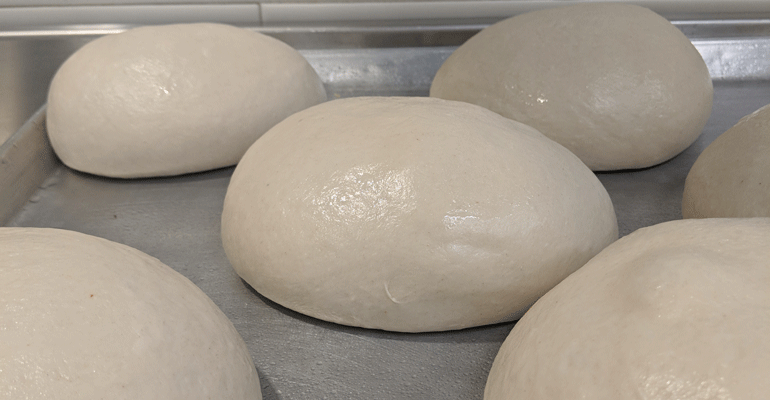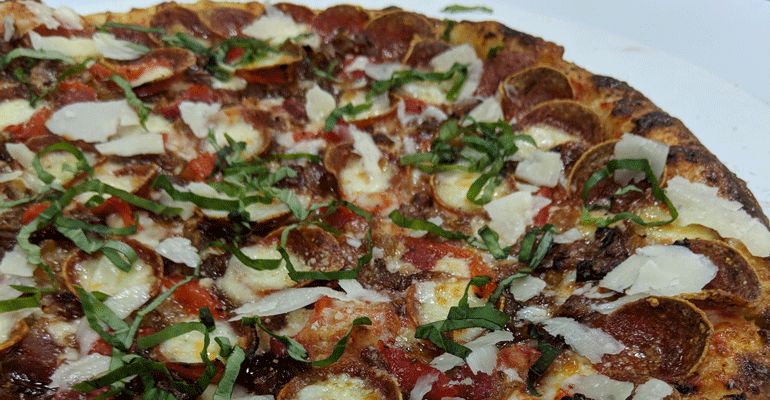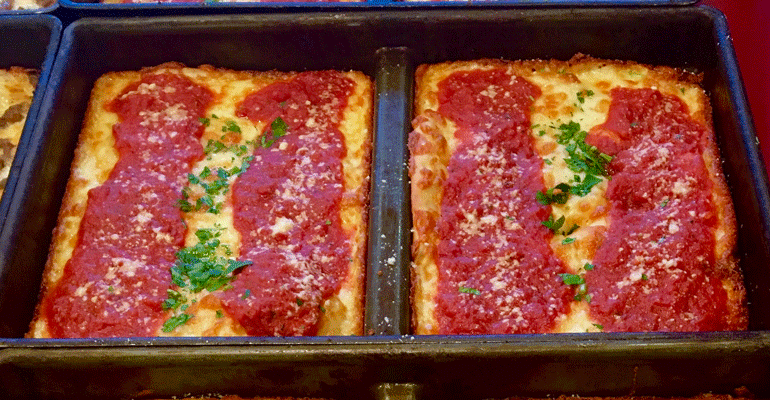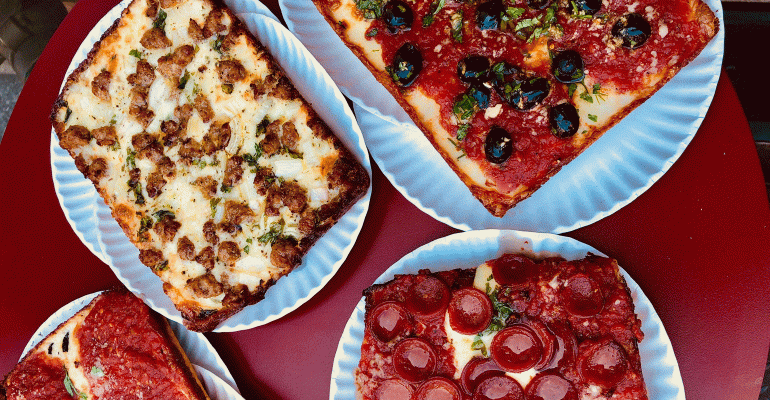Toppings often appear to be the star of a pizza, and premium meats, varied vegetables and exotic cheeses have all found their place on the pie in recent years, but now crusts are in play. Operators are experimenting with sourdough starters, slow-rising dough-making techniques, different flour-to-water ratios and more to create different flavors and new combinations of and crunch and pull that result in unique eating experiences and keep customers coming back for more.
“Pizza is a very personal thing for people. You grow up, you have Friday-night pizza with your family, and you have Angie’s down the street, and in your head you have to think that’s what pizza should be,” said Kyle Rosch, who has studied pizza all over the world. He currently is director of operation for several concepts: Enzo’s Pizza Co. in Durham, N.C.; Brenz Pizza, which has restaurants in Chapel Hill, N.C., Knoxville, Tenn., and Columbus, Ohio; and Il Forno, located in Duke University’s Brodhead Center, a food hall on the college’s west campus in Durham, N.C.
“Dough is super complex,” he said. “There’s millions of ways to do it, and that’s the fun part.”
Pizza consultant Anthony Falco leans into that complexity with his sourdough starter, which has traveled around the world with him. He uses it for the crust at Upside Pizza in New York City, allowing for a naturally leavened crust, meaning it contains no commercial yeast.
Upside founder Noam Grossman said making pizza from a starter is rewarding, but it’s lot of work.
“It requires much more time and careful attention than a pizza that uses [commercial] yeast, and I’m super passionate about it,” he said.

Like many other sourdough handlers, Grossman treats his starter as a member of the family — a helpless infant, to be exact. “I’m up before the sun to feed the starter, and we keep all of our conditions incredibly controlled,” he said, “It’s definitely a labor of love but it’s worth it.”
But for a big operation like Il Forno, uniformity in dough trumps heirloom starters, Rosch said.
“A one-shot pizzeria can have a starter that you feed and name it like a little baby and it really creates some interesting flavors,” Rosch said. But Il Forno can operate at speeds of up to 200 pizzas per hour, and coddling finicky dough just isn’t practical.
But that doesn’t mean there’s not an art to the dough, even in big production. Just using a good yeast can be a differentiator.
“The yeast gives it that tang and that bite, and that may separate you from some guy using the same flour,” Rosch said. “Yeast, time and temperature are the main factors for manipulating dough.”
Pizza dough’s flavor and texture depend largely on time and temperature, Rosch said. For a Neapolitan-style pizza, you need very finely ground flour and ovens that run upwards of 800° Fahrenheit.

Enzo’s, Rosch’s freestanding concept in Durham, features pizza from ovens that usually run around 480°F, more suited to New York-style crust.
Il Forno’s ovens use a combination of gas and wood, and can get hotter Enzo’s, allowing for more of a fast-cooking Neapolitan-style crust, but Rosch said he serves customers a product that falls between those two styles, since Americans tend to prefer the New York-style crust.
“With Neapolitan style, some people don’t understand and think it’s burned,” he said.
Flour-to-water ratio’s important to, Rosch said.
“New York-style crust finds a happy medium of high-gluten flour and a hydration level of 65%. That affects the flour and how it breaks down the elasticity of the dough,” he said. “That’s the chew or the pull — the sensation of eating a slice of New York pizza.”

Temperature also matters: Rosch starts with water at 62° Fahrenheit.
Although he stays away from sourdough, Rosch does use another process that helps develop flavor in the dough: Cold fermentation. Instead of letting his batch of dough rise over the course of a few hours at room temperature, he portions it into single-pizza balls and chills and lets it rise refrigerated for up to 96 hours. He said that gives the yeast time to develop flavor and contribute to the brown bubbles and dough pockets that make a great crust.
But in a pinch, if the dough doesn’t rise properly or if they run out, he speeds up the process.
“Instead of 62° water, we can do 82° water and instead of refrigeration we’ll let it sit on the counter for three hours,” Rosch said.

While Rosch is sticking to his New York-Neapolitan hybrid style of crust, he’s also keeping an eye on a hot trend: Detroit pizza, known for its square bubbly edges.
“It’s definitely more labor intensive, since you have to press it out inside the pan,” he said, adding that he’ll probably start tinkering with that soon enough.
Rosch and other pizza pros are looking to operators like Lions & Tigers & Squares in New York City, where the focus is on Detroit-style pizza, characterized by its square shape and caramelized cheese crust.

The process for a Detroit crust is entirely different than a New York-style crust, and as Rosch observed, it can be seen as more work. A Motor City dough starts with a higher water percentage and more fat, which gives the crust an appearance more like a golden-brown grilled cheese sandwich than to other pizzas.
Crust innovation is getting serious at Pieology Pizzeria, a stone-oven pizza chain based in Rancho Santa Margarita, Calif., with nearly 150 restaurants nationwide. It recently rolled out a deep-dish crust that is pressed the night before to allow for overnight rising. The finished crust has caramelized edges, checking a major box for deep-dish enthusiasts.
“We know the best pizza starts with the best crust, and are excited to offer Pieology fans more crust options,” said Chad Bailey, Pieology vice president of marketing. In addition to the deep-dish crust, the chain also offers thin and whole-wheat crusts, as well as a gluten-free option and, as part of another growing trend, a cauliflower crust.

Cauliflower is a star among carb-conscious Pinterest users’ as a substitute for rice, and it’s also increasingly used as the basis for low carb, gluten-free options for pizza.
It plays that role at Joe’s Pizza, which has three locations in Los Angeles and West Hollywood, Calif. Owner Giuseppe Vitale’s signature crust is light and crisp, and so is the cauliflower crust, part of a new vegan pie.
It’s also a newcomer at PizzaRev, a fast-casual brand with 38 U.S. units, which partnered with manufacturer Caulipower to launch a new crust last October as a permanent addition to the menu.





